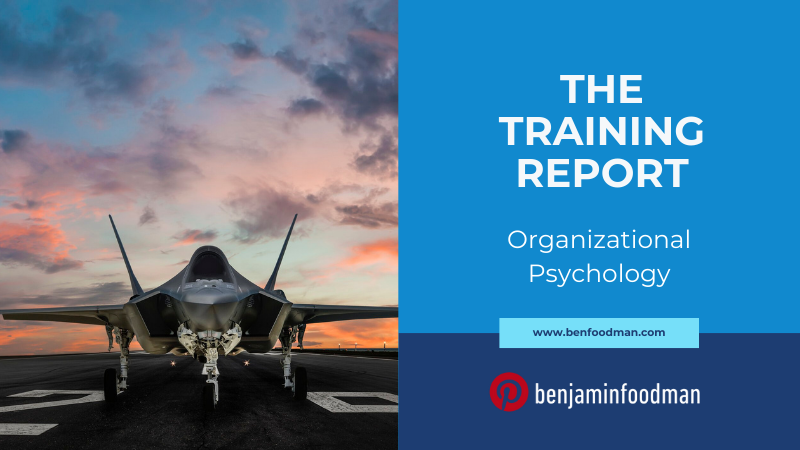Organizational Psychology - 3 Simple Strategies For Building A New Team Position From Scratch
About the Author
Ben Foodman is a licensed psychotherapist & performance specialist. He owns his private practice located in Charlotte North Carolina where he specializes in working with athletes to help them overcome mental blocks (the yips), PTSD, ADD / ADHD and achieve flow states through the techniques of Brainspotting & Neurofeedback. If you are interested in services, use the link here! Enjoy the article below!
Introduction: US Naval Aviation, Organizational & Performance Psychology
During my time observing flight operations aboard the USS Nimitz, I was able to see first hand how the US Military takes organizational psychology to a whole new level. A carrier strike group consists of many different moving parts and yet needs to be perfectly synchronized in order to achieve peak performance. Not only does this mean that both ships and air craft need to be operating in unison, but so to do the personnel.
Many of the strategies that the US Navy used actually have universal application both in the sport and corporate performance space. For this Training Report, I want to review strategies that the US Navy uses to help people with organizational cohesion when it comes to integrating a new position within that team. One of the first strategies we will review is the importance of having a clear vision and mission statement for new personnel.
Part I. Sport Psychology, Clear Visions & Mission Statements
When organizations are growing at scale, new issues will present themselves due to the evolving nature of the environmental demands. This makes sense because obviously the more you want to do, and the more efficient you want to do those things, the more you will recognize where the most growth needs to happen. Because of this, organizations will create new positions that they believe will help them adapt to the changing environment. But there is a constant that must remain when establishing new organizational positions regardless if one is in the military, sport or corporate sector. Organizations need to make sure that the personnel they bring into the organization has their shared vision and mission statement in mind. During my time aboard the USS Nimitz I was able to witness this first hand wherever I went aboard the aircraft carrier.
Per the United States Navy ‘The United States is a maritime nation, and the U.S. Navy protects America at sea. Alongside our allies and partners, we defend freedom, preserve economic prosperity, and keep the seas open and free. Our nation is engaged in long-term competition. To defend American interests around the globe, the U.S. Navy must remain prepared to execute our timeless role, as directed by Congress and the President’. Whether you were a fighter pilot, engineer or admiral aboard the Nimitz, everything you were doing was driven by this statement. Regardless of the type of organization you have, make sure that both the new job position and personnel who take over this position share your vision and mission statement! Let’s now review the next critical strategy for successfully building a new organizational position: communication!
Part II. New Organizational Positions, Communication & Leadership
When organizations develop new positions, they oftentimes will look for characteristics of leadership within the new candidates. While this is an important feature to have, I believe that leadership characteristics are really outcomes rather than processes. Oftentimes, it can be difficult to identify what leadership characteristics are most important and each organization will most likely have their own unique needs that require unique leadership characteristics. But I believe there is one that universally stands out.
When looking at the research behind leadership development, communication skills often comes up as a critical feature for successful leadership. So what does this mean and what does this look like? First, team leaders of the organization should maintain an ‘open door’ policy when interacting with new team members that are building the new job position, and vice versa. This will help build trust & cohesion. Finally, communication should be honest and transparent. Sometimes this means people will need to hear things they don’t want to hear, but when building a new organizational position, the truth is the only remedy for success.
Part III. Receiving Feedback From New Organizational Positions
Continuing on the trend of communication, all positions need to be open to receiving honest feedback. From the leader’s perspective, this may be understandably difficult to do. But if you have personnel who are helping you build new organizational positions, they will be the ‘eyes and ears’ as to what is happening on the front-line. As a leader, you cannot always be on the front line if you want to successfully run a large organization, so if you have hired the right personnel it is in your best interest to hear what they have to say about positional needs even if it is inconvenient. Ultimately if you are running a large organization and implementing a new position to help grow your team, these strategies will serve you well in being successful at achieving your goals!
Note To Reader:
If you are an athlete reading this segment of the TRAINING REPORT, hopefully this content was helpful! I put the Training Report together because I felt like many of the discussions on issues such as the Yips/mental blocks, strength training & other subject matter on athlete performance concepts were really missing the mark on these ideas (e.g. how trauma is the direct cause of the Yips). If you are interested in learning more, make sure to subscribe below for when I put out new content on issues related to sport psychology & athlete performance! Also, if you are looking to work with a mental performance specialist, you are in the right place! USE THIS LINK to reach out to me to see if my services are the right fit for your goals!
ARE YOU ON THE LIST?
Make sure you’re signed up to Ben’s mailing list to receive news & updates on new strategies in sport psychology, upcoming workshops & products. Don’t wait, sign up now!

















